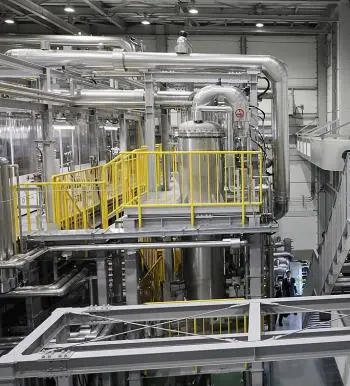
Hydrogen is playing a fundamental role in the mobility and energy generation revolution, especially in the context of hydrogen engines.
However, behind the futuristic vision of these engines and their promising potential, lies an essential process: the production of hydrogen.
In this article, we will explain the hydrogen production process in detail. Discover the key technologies that make the manufacturing of this versatile fuel possible.
Hydrogen production technologies
Water electrolysis

There are two main types of electrolysis: alkaline electrolysis and proton exchange membrane (PEM) electrolysis. Both methods are clean and can be powered by renewable energy, such as solar or wind.
Hydrocarbon reform
Hydrocarbon reforming is a process that involves the reaction of a hydrocarbon (such as methane) with water vapor to produce hydrogen and carbon dioxide.
This method is efficient and widely used in industry, but produces CO2 as a byproduct, raising environmental concerns.
Biomass pyrolysis
Biomass pyrolysis involves the thermal decomposition of organic matter (such as wood or agricultural waste) in the absence of oxygen. The resulting gas contains hydrogen, carbon monoxide and methane, which can be purified to obtain pure hydrogen.
Photolysis and thermolysis
These experimental methods use solar radiation or extreme heat to split water into hydrogen and oxygen. Although promising from a sustainability point of view, they are still under development and not widely used.
Challenges in hydrogen production
Despite advances in hydrogen production, there are several challenges that must be addressed to drive this industry towards sustainability and efficiency:
Energy consumption
Producing hydrogen through electrolysis requires a significant amount of electricity, which can increase demand on the electrical grid.
Improving the efficiency of electrolytic cells and integrating renewable energy is crucial to reducing energy consumption.
Storage and distribution
Hydrogen is a light and highly flammable gas, making it challenging to store and transport safely. Adequate infrastructure is required to ensure safe handling and efficient distribution.
Production costs
Although hydrogen production costs have decreased in recent years, it is still more expensive to produce compared to fossil fuels.
Cost reduction is essential to make hydrogen competitive in different applications.
Environmental impact
In the case of hydrocarbon reforming, the production of hydrogen involves the emission of CO2. Carbon capture and storage (CCS) is a potential solution, but its large-scale implementation poses technical and economic challenges.
Scalability and demand
As demand for hydrogen increases, production needs to be scaled. This will require significant investments in infrastructure and technology to meet the growing need.
Sustainable production
For hydrogen to contribute to the reduction of greenhouse gas emissions, it is essential that production is based on renewable energy sources and low-carbon processes.
Which countries lead the production of hydrogen?
Hydrogen production is a growing field and several countries are competing to lead this emerging industry. Countries leading hydrogen production can vary depending on production method and focus on clean or conventional hydrogen. Some of the leading hydrogen producing countries include:
China
China has been investing significantly in hydrogen production, with a focus on green hydrogen produced from renewable energy sources.
It has developed significant infrastructure for hydrogen production and distribution and is working on hydrogen mobility projects such as hydrogen buses and freight trucks.
Japan
Japan is a world leader in the adoption of hydrogen technologies and has been driving research and development in this field for decades.
The country is focusing on hydrogen produced from renewable energy and has ambitious plans to use hydrogen in mobility and power generation applications.
South Korea
South Korea has invested in the development of fuel cell technologies and is actively promoting hydrogen mobility.
It is also investing in the production of hydrogen from renewable energy sources.
Germany
Germany has been expanding its green hydrogen production capacity and is committed to transitioning to a hydrogen economy. The country has announced significant investments in hydrogen technologies and pilot projects.
USA
The United States is working to boost hydrogen production, especially in the area of green hydrogen. Several companies and research projects are contributing to the development of this industry.
Netherlands
The Netherlands is investing in hydrogen production and storage projects, with a focus on the production of green hydrogen from renewable energy.
Australia
Australia, with its abundance of renewable resources, is working on the production and export of green hydrogen. It has projects underway to produce and export hydrogen internationally.